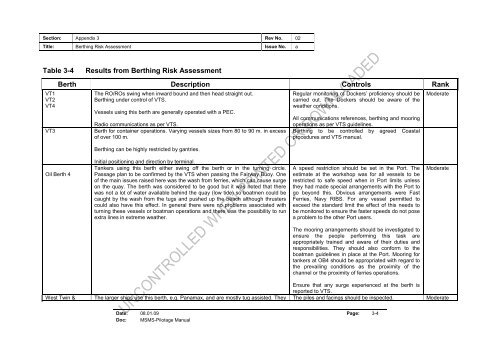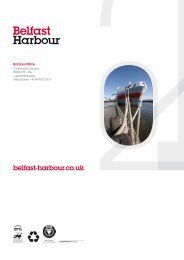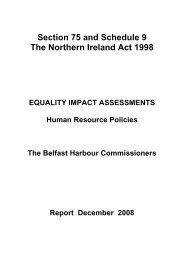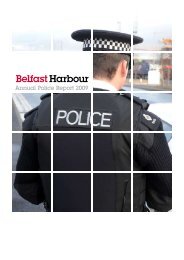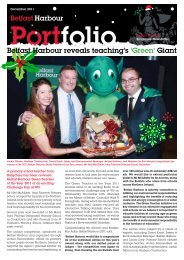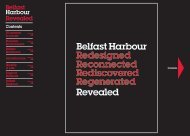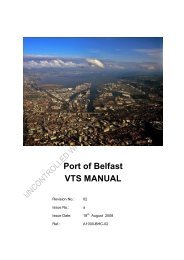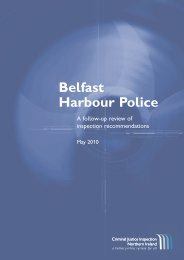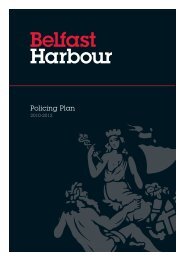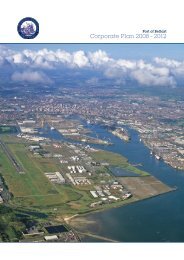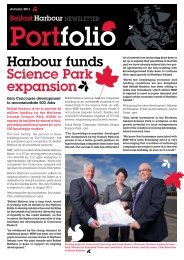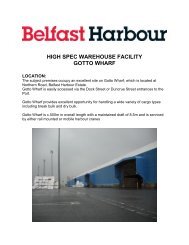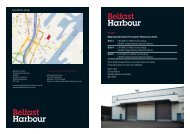Pilotage Manual - Belfast Harbour
Pilotage Manual - Belfast Harbour
Pilotage Manual - Belfast Harbour
You also want an ePaper? Increase the reach of your titles
YUMPU automatically turns print PDFs into web optimized ePapers that Google loves.
Section: Appendix 3 Rev No. 02<br />
Title: Berthing Risk Assessment Issue No. a<br />
Table 3-4<br />
Results from Berthing Risk Assessment<br />
VT1<br />
VT2<br />
VT4<br />
VT3<br />
Berth Description Controls Rank<br />
The RO/ROs swing when inward bound and then head straight out.<br />
Berthing under control of VTS.<br />
Vessels using this berth are generally operated with a PEC.<br />
Radio communications as per VTS.<br />
Berth for container operations. Varying vessels sizes from 80 to 90 m. in excess<br />
of over 100 m.<br />
Berthing can be highly restricted by gantries.<br />
Regular monitoring of Dockers’ proficiency should be<br />
carried out. The Dockers should be aware of the<br />
weather conditions.<br />
All communications references, berthing and mooring<br />
operations as per VTS guidelines.<br />
Berthing to be controlled by agreed Coastal<br />
procedures and VTS manual.<br />
Moderate<br />
Oil Berth 4<br />
Initial positioning and direction by terminal.<br />
Tankers using this berth either swing off the berth or in the turning circle.<br />
Passage plan to be confirmed by the VTS when passing the Fairway Buoy. One<br />
of the main issues raised here was the wash from ferries, which can cause surge<br />
on the quay. The berth was considered to be good but it was noted that there<br />
was not a lot of water available behind the quay (low tide) so boatmen could be<br />
caught by the wash from the tugs and pushed up the beach although thrusters<br />
could also have this effect. In general there were no problems associated with<br />
turning these vessels or boatman operations and there was the possibility to run<br />
extra lines in extreme weather.<br />
A speed restriction should be set in the Port. The<br />
estimate at the workshop was for all vessels to be<br />
restricted to safe speed when in Port limits unless<br />
they had made special arrangements with the Port to<br />
go beyond this. Obvious arrangements were Fast<br />
Ferries, Navy RIBS. For any vessel permitted to<br />
exceed the standard limit the effect of this needs to<br />
be monitored to ensure the faster speeds do not pose<br />
a problem to the other Port users.<br />
Moderate<br />
The mooring arrangements should be investigated to<br />
ensure the people performing this task are<br />
appropriately trained and aware of their duties and<br />
responsibilities. They should also conform to the<br />
boatman guidelines in place at the Port. Mooring for<br />
tankers at OB4 should be appropriated with regard to<br />
the prevailing conditions as the proximity of the<br />
channel or the proximity of ferries operations.<br />
Ensure that any surge experienced at the berth is<br />
reported to VTS.<br />
West Twin & The larger ships use this berth, e.g. Panamax, and are mostly tug assisted. They The piles and facings should be inspected. Moderate<br />
Date: 08.01.09 Page: 3-4<br />
Doc: MSMS-<strong>Pilotage</strong> <strong>Manual</strong>


